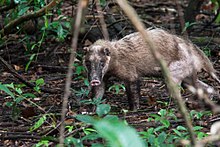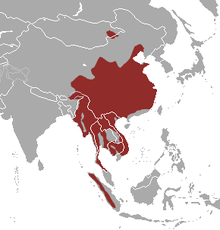Arctonyx collaris
| Hog badger | |
|---|---|
 |
|
| Arctonyx collaris in Huai Kha Khaeng Wildlife Sanctuary, Thailand. | |
| Scientific classification | |
| Kingdom: | Animalia |
| Phylum: | Chordata |
| Class: | Mammalia |
| Order: | Carnivora |
| Family: | Mustelidae |
| Subfamily: | Mustelinae |
| Genus: |
Arctonyx Cuvier, 1825 |
| Species: | A. collaris |
| Binomial name | |
|
Arctonyx collaris Cuvier, 1825 |
|
 |
|
| Hog badger range | |
The hog badger (Arctonyx collaris), also known as greater hog badger, is a terrestrial mustelid native to Central and Southeast Asia. It is listed as Vulnerable in the IUCN Red List of Threatened Species because the global population is thought to be declining due to high levels of poaching.
It has medium-length brown hair, stocky body, white throat, two black stripes on an elongated white face and a pink, pig-like snout. The head-and-body length is 55–70 cm (22–28 in), the tail measures 12–17 cm (4.7–6.7 in) and the body weight is 7–14 kg (15–31 lb).
Its appearance generally resembles the European badger, but it is generally smaller, with larger claws on the front feet. Its tail has long white hairs, and its front feet have white claws.
Hog badgers are considered fairly common in Thailand and in tropical evergreen forests and grasslands of the Terai in north-eastern India. They occur in Indochina and in southern China. Their distribution in Myanmar is considered patchy. In the Indonesian island of Sumatra, hog badgers occur primarily above 2,000 m (6,600 ft) with one record at 700 m (2,300 ft). There is one isolated record in eastern Mongolia.
The following subspecies are recognized:
The IUCN has declared the greater hog badger (Arctonyx collaris), the northern hog badger (Arctonyx albogularis) and the Sumatran hog badger (Arctonyx hoevenii) as three separate species. The greater hog badger is listed as vulnerable, while the other two are listed as least concern.
...
Wikipedia

